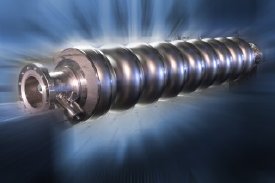Feb 9 2010
In a 1954 speech to the American Physical Society, the University of Chicago's Enrico Fermi fancifully envisioned a particle accelerator that encircled the globe. Such would be the ultimate theoretical outcome, Fermi surmised, of the quest for the ever-more powerful accelerators needed to discover new laws of physics.
 Superconducting radio frequency cavities are a key technology for next-generation accelerators and the future of particle physics.
Superconducting radio frequency cavities are a key technology for next-generation accelerators and the future of particle physics.
"How much energy you can put into a particle per meter corresponds directly to how big the machine is," says Steven Sibener, the Carl William Eisendrath Professor in Chemistry and the James Franck Institute at UChicago. This means that future accelerators must either grow to inconceivable sizes, at great costs, or they must somehow pump far more energy into each particle per meter of acceleration than modern technology will allow.
Sibener and Lance Cooley, AB'86, of the Fermi National Accelerator Laboratory, are working on the latter option with $1.5 million in funding from the U.S. Department of Energy. They aim to improve the efficiency of superconducting radio frequency (SRF) cavities made of niobium to accelerate beams of subatomic particles in the next generation of high-energy physics experiments.
The result could be accelerators powerful enough to open new frontiers in physics without the need for a massive increase in size.
A key to such efforts is niobium, a metallic element that becomes superconducting at very low temperatures. In fact, niobium's superconducting characteristics are the best among the elements, providing the capacity to carry thousands of times more electric current than normal conductivity through copper. When highly pure, niobium also efficiently sheds any heat generated at flaws and defects to its cryogenic coolant. Niobium SRF cavities thus will comprise the heart of future particle accelerators, including the proposed International Linear Collider.
Enabling collider technology
"The niobium superconducting cavity is enabling technology for anything that is high-power, high-energy, or high-intensity for linear colliders," says Cooley, the SRF Materials Group Leader at Fermilab. Cooley works with niobium cooled to 2 Kelvin (minus-455.8 degrees Fahrenheit) to maximize its superconducting characteristics. "We use superconductors because it's friction-free electricity, which saves on the operating wall-plug power," he says.
As an undergraduate at UChicago in the 1980s, Cooley conducted research for his senior project in the laboratory of Thomas Rosenbaum, Provost and the John T. Wilson Distinguished Service Professor in Physics. It was then that Cooley became interested in superconductivity. His interest in Fermilab and its accelerators was motivated by another UChicago faculty member, Professor Emeritus and Nobel Laureate James Cronin. Cooley arrived at Fermilab in 2007, and soon after, met Sibener to discuss niobium surface chemistry at the recommendation of mutual colleagues.
Pushing particle beams
Niobium has assumed greater importance in plans for the next round of linear colliders. The current generation of ring colliders, including Fermilab's Tevatron and Europe's newly operating Large Hadron Collider, use thousands of niobium-titanium superconducting magnets to steer and focus their beams of charged particles, which travel in great loops before being steered into collisions that can reveal fundamental properties of matter. Cavities are a small part of these machines, providing a momentary push to the particles each time they orbit the ring.
But linear colliders, including Stanford's current linear accelerator, Fermilab's proposed Project X, and the proposed ILC, string together thousands of cavities into one long line. The resulting linear accelerator creates an immense electric field to push the particle beams toward their collision in a single pass, without any need for steering and recirculating them.
The emergence of niobium SRF cavity technology over the past 20 years makes it possible for each resonating cavity to utilize superconductivity to produce high-power output through low-power input, with an estimated gain in quality factor of 100,000 over Stanford's copper cavities. But many aspects of the system are not yet optimal.
Niobium is processed according to laboratory recipes that could benefit from a firm grounding in materials science, Cooley says. "Just how precisely a given recipe is followed depends on laboratory culture, attention to detail by individual operators, arrangement of tasks based on what is perceived to be important, and so on," Cooley says. "The true impact of different processing steps is just beginning to emerge as the university scientists like Steve step in and produce basic understanding."
The microscopes in Sibener's laboratory enable researchers to observe the behavior of individual atoms. With the earlier seed grant, Sibener's team found that niobium's reaction with oxygen produced a variety of surface oxides and defects that suggested to Cooley and others explanations of observed changes in real-world SRF cavities.
"This is some of the purest niobium you can find in the world, actually," says Sibener, displaying a mirror-like wafer of the material in his office at the Gordon Center for Integrative Science. His research group will closely examine the material to determine exactly which oxides and defects at the surface of niobium crystals lead to loss of superconductivity under extreme conditions.
"If the Fermilab-UChicago collaboration is successful," says Cooley, "it will allow new types of accelerators to be built at great cost savings."